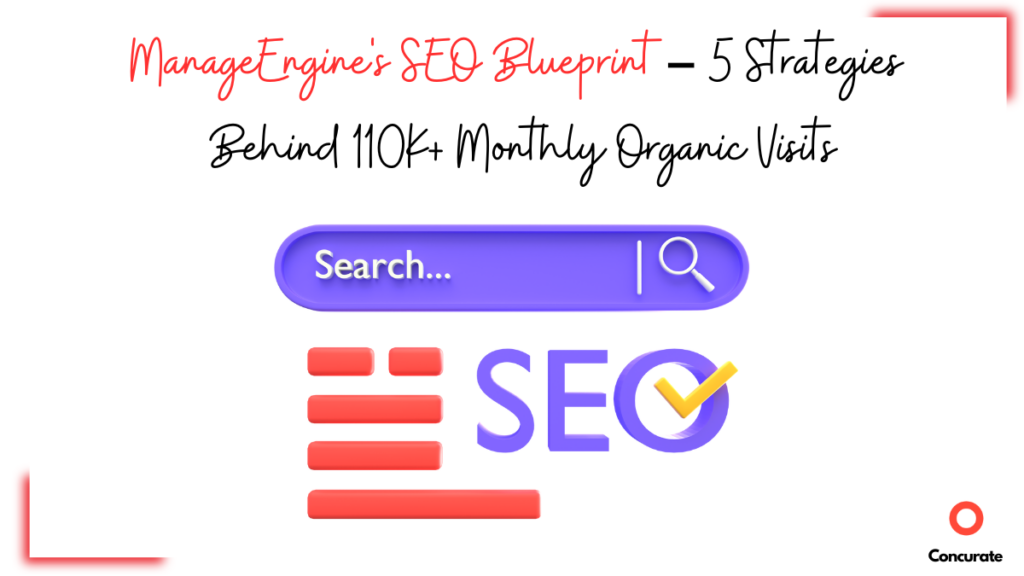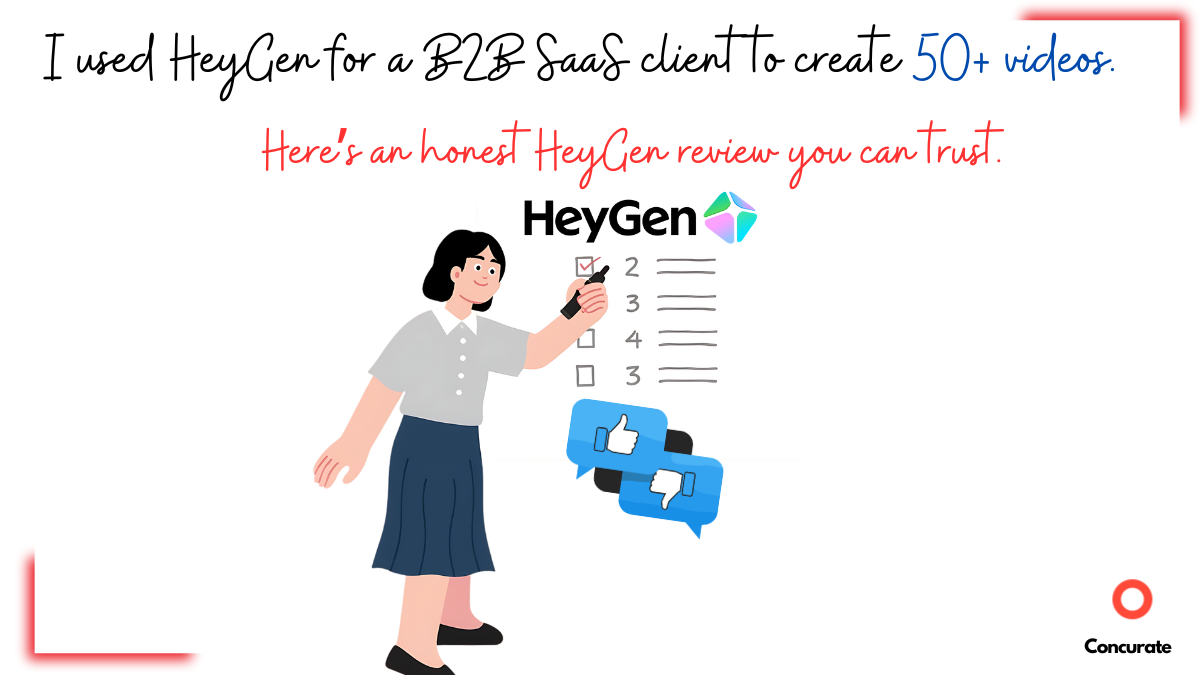You don’t need 3.7 million backlinks. You need pages that print pipeline.
ManageEngine isn’t just ranking; they’re owning search intent in the IT management space.
With 115,000+ monthly organic visitors, they’re pulling traffic from every angle:
- Users searching for niche errors like “0x80070643”
- Buyers comparing tools like “Spiceworks vs ServiceDesk”
- IT pros googling “Active Directory audit” at 2AM
And here’s what makes it brilliant:
They’re not flooding the web with fluffy blogs or chasing LinkedIn likes.
They’re building product-led content ecosystems that capture, convert, and compound.
This teardown shows:
● How ManageEngine ranks for 1,000+ keywords on a single product page
● How a single troubleshooting guide pulls $150+ in traffic value monthly
● How to learn from this strategy
ManageEngine’s SEO Snapshot: The Numbers That Matter
| Organic Traffic (Monthly) | 115K |
| Domain Rating (DR) | 80 |
| Backlinks | 3.7M |
How ManageEngine Captures Traffic: Breaking Down the Sources
#1 Branded searches: 56.7K visits (Users already familiar with the brand)
#2 Non-branded searches: 58K visits (Capturing users before they know the brand)
#3 Informational searches: 95.4K visits (Users seeking knowledge and insights)
#4 Navigational searches: 22.1K visits (Users looking for a specific website or page)
#5 Commercial searches: 52.7K visits (Users researching before making a purchase)
Traffic MVPs: Top Pages Driving ManageEngine’s Success
| Page | Keyword | Position | Monthly Traffic |
| manageengine.com | manageengine | 1 | 8,680 |
| Service Desk | servicedesk | 2 | 2,568 |
| Desktop Central | manageengine endpoint central | 1 | 1,726 |
| Fix Windows Update Error | download error – 0x80070643 | 6 | 1,667 |
| Mobile Device Management | manageengine mdm | 1 | 1,592 |
| Network Monitoring | opmanager | 1 | 1,231 |
| Self-Service Password | adselfservice plus | 1 | 1,156 |
| AD Manager | admanager plus | 1 | 1,122 |
| NetFlow | netflow analyzer | 1 | 1,043 |
| Active Directory Audit | adaudit | 1 | 962 |
ManageEngine’s Traffic Playbook
#1 The homepage dominates, ranking #1 for “ManageEngine” and attracting users already familiar with the brand.
#2 Service-driven pages like “Service Desk” and “Desktop Central” convert visitors exploring IT management solutions.
#3 Niche troubleshooting content, like the Windows update error page, pulls in users searching for quick fixes.
Scaling an IT SaaS business isn’t just about organic traffic; it’s about adoption. See how leading brands implement SaaS adoption strategies to drive user engagement.
ManageEngine Wins with Search Intent
#1 Branded searches bring in high-intent users, with “ManageEngine” and “AdManager Plus” securing top rankings.
#2 Informational content works, as the “download error – 0x80070643” page capitalizes on urgent tech queries.
#3 Product-focused pages like “Mobile Device Management” and “Self-Service Password” cater to decision-makers evaluating enterprise tools.
ManageEngine’s Profile: How They Build Authority
| Metric | Value |
| Total backlinks | 3.7M |
| Referring Domains | 10.1K |
| High-Authority Links | Links from Google, Apple, Wikipedia, Microsoft, |
Insights
#1 A strong backlink profile with 3.7M total backlinks signals high domain authority and trust across the IT industry.
#2 High-value links from Google, Apple, Wikipedia, and Microsoft boost credibility, reinforcing ManageEngine as a go-to enterprise IT solutions provider.
ManageEngine’s Traffic by Location
| Country | Monthly Visits | % of Total Traffic |
| United States | 114.7K | 32.0% |
| India | 85.2K | 23.7% |
| United Kingdom | 15.8K | 4.4% |
| Brazil | 13.3K | 3.7% |
| Mexico | 9.3K | 2.6% |
Insights from Traffic Data
#1 The U.S. leads the traffic share, accounting for nearly a third of visits, showing strong demand for ManageEngine’s solutions in North America.
#2 India is a major market, contributing 23.7% of traffic, likely driven by IT professionals and enterprises seeking management and security solutions.
ManageEngine’s Technical Health
Core Web Vitals (Desktop):
Largest Contentful Paint (LCP): 1.8s (Good)
Cumulative Layout Shift (CLS): 0.05 (Good)
Interaction to Next Paint (INP): 42s (Excellent)
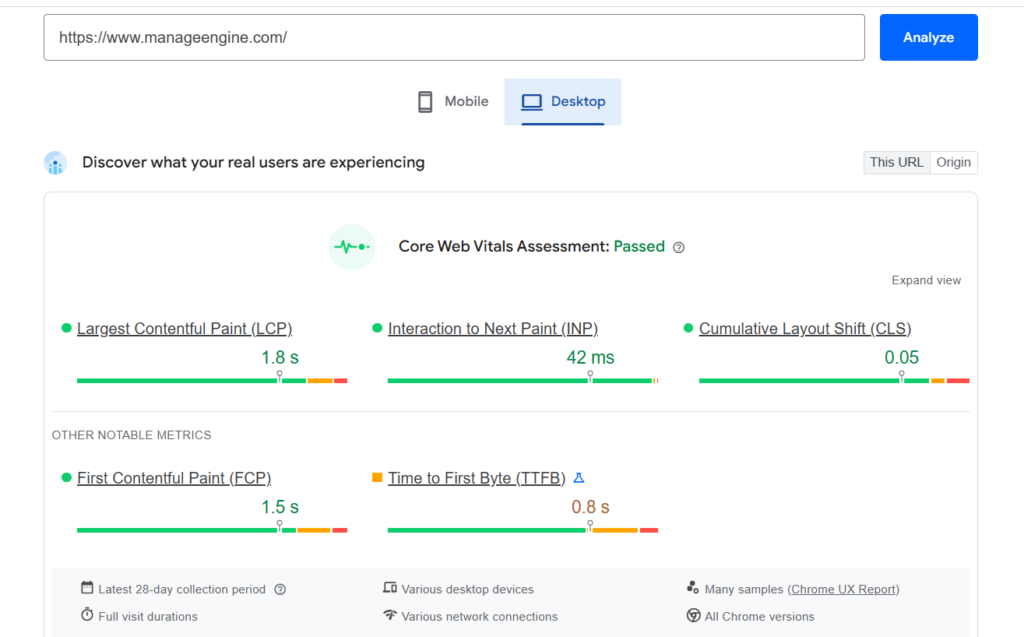
Source: PageSpeed Insights
#1 With an LCP of 1.8s, ManageEngine delivers a smooth user experience, reducing bounce rates and keeping visitors engaged.
#2 A CLS of 0.05 ensures minimal layout shifts, preventing frustrating interactions and improving usability.
Traffic Breakdown
| Source | Value |
| Organic Search | 115K |
| Paid Search | 10.5K |
Paid Ad Keywords That Drive Conversion
Bidding on “Bitwarden download” and “HP Wolf Security” shows ManageEngine is targeting cybersecurity-conscious users.
Top Keywords ManageEngine Is Bidding On:
#1 “bitwarden download”
#2 “cherwell”
#3 “adselfservice plus”
#4 “network scanner”
#5 “prtg”
#6 “spiceworks help desk”
#7 “hp wolf security”
Insights
#1 Keywords like “Cherwell” and “Spiceworks Help Desk” indicate a focus on businesses searching for IT service management solutions.
#3 Terms like “network scanner” and “PRTG” suggest ManageEngine is competing for visibility in the network infrastructure space.
5 Reasons ManageEngine Gets 110K+ Organic Monthly Visits
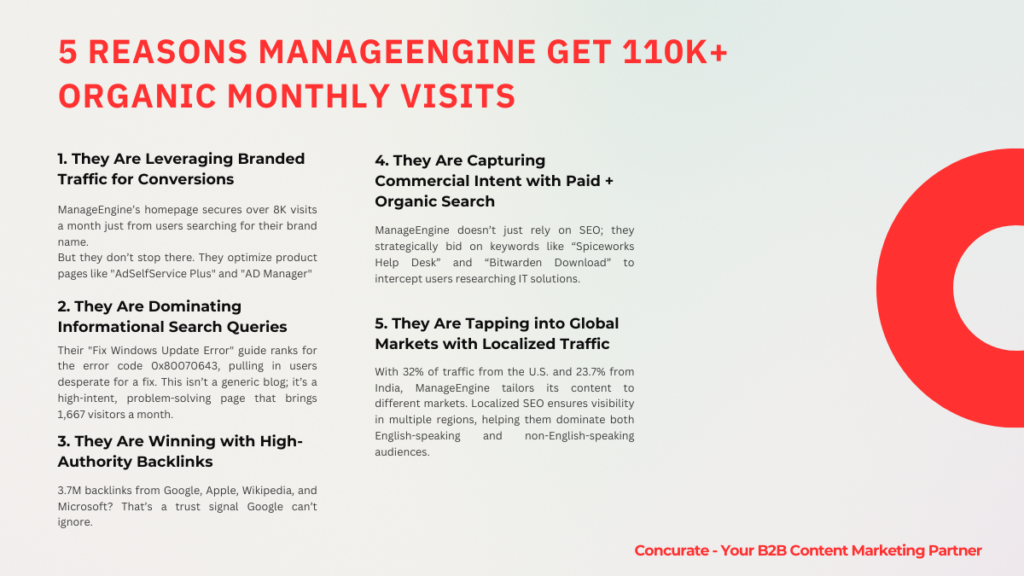
#1 Turn Your Product Pages Into Conversion Engines
ManageEngine isn’t just attracting traffic; it’s capturing high-intent buyers. Their AD Manager and ADSelfService Plus pages are optimized to rank for keywords decision-makers actually search when evaluating IT tools.
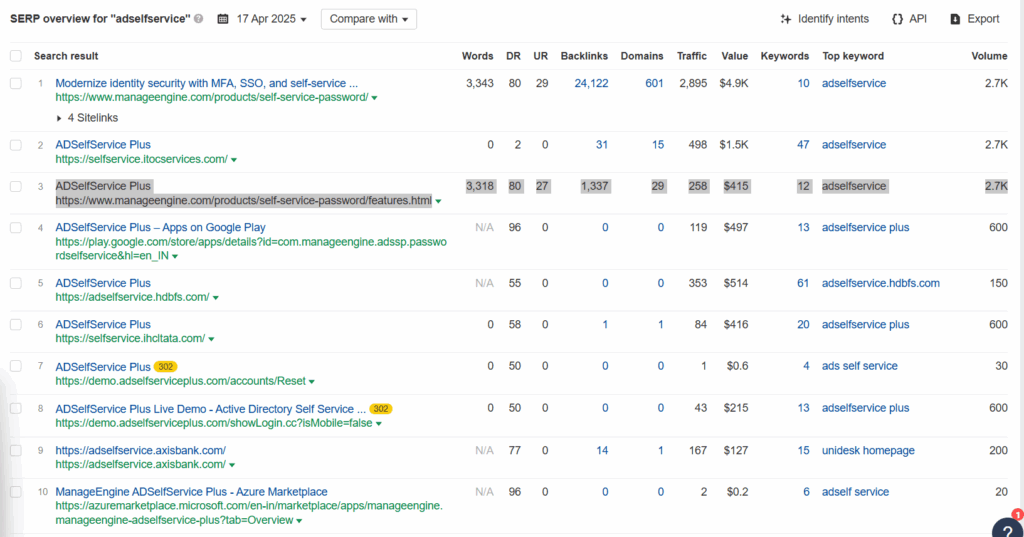
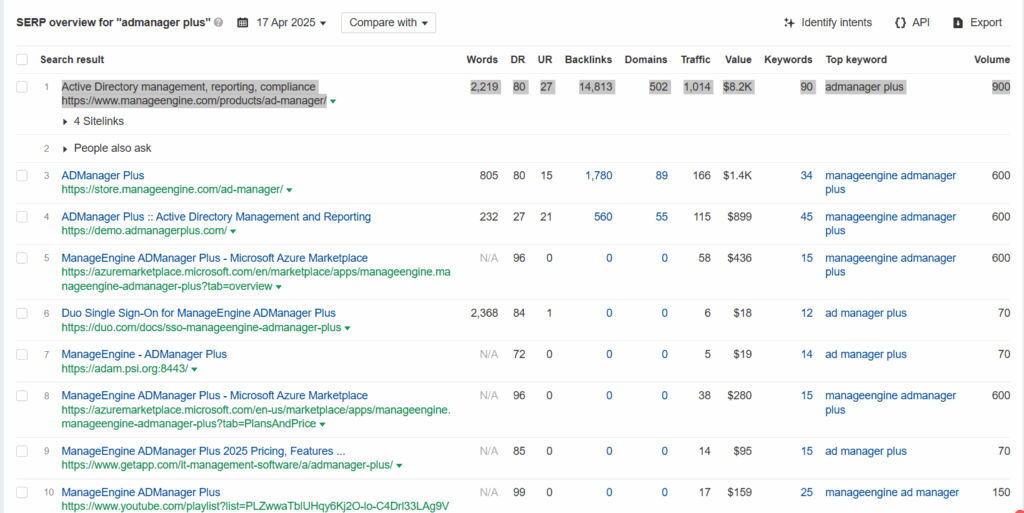
What ManageEngine Did Right:
● Optimized commercial product pages for high-volume, transactional keywords.
● Earned backlinks from 258+ domains to the ADSelfService page alone.
● Used clear keyword targeting like “admanager plus” (900 volume) and “adselfservice” (2.7K volume).
● Captured over 1,000 keywords on a single product page, driving organic traffic with high buyer intent.
SaaS Playbook: Things To Learn
Turn your product pages into SEO landing pages by: a) Targeting branded or product-specific queries (e.g., “[Product] features” or “[Product] login”)
b) Adding FAQ schema for SERP dominance
c) Linking internally from support docs and blog content to pass authority
Takeaway:
If your brand has recognition, don’t just rank; optimize your product pages for conversions.
#2 Capture Urgent Searches with Problem-Solving Content
Their “Fix Windows Update Error” guide ranks #3 for the error code 0x80070643, pulling in users desperate for a fix. This isn’t a generic blog; it’s a high-intent, problem-solving page that brings value of $150+.

What ManageEngine Did Right:
● Created content that directly targets a high-volume error keyword (“0x80070643” with 6.9K monthly searches).
● Focused the page on problem-solving rather than generic blog content.
● Built authority with a strong domain (DR 80), even with minimal backlinks or referring domains.
● Matched user urgency with clear fixes and context-specific advice.
SaaS Playbook: Things To Learn
Turn technical support into a growth engine:
a) Identify top error codes, issues, or FAQs in your niche
b) Create dedicated pages titled “How to fix [problem]” with clear steps
c) Add CTAs like “Use [Product] to avoid this error in the future”
Takeaway:
Problem-solving pages aren’t fluff. They’re search magnets that build trust and funnel users straight into your ecosystem.
#3 Own Both TOFU and BOFU by Pairing Utility with Product
ManageEngine isn’t just chasing traffic; they’re owning high-intent, utility-focused keywords and their core commercial terms. They rank #2 for “linux rename file” and #1 for “servicedesk”, showing they can dominate both how-to searches and buyer-ready queries.
What ManageEngine Did Right:
● Utility-first content: Their “Renaming Files in Linux” guide brings in over 3,100 visitors per month with a search value of $229; despite having just 3 referring domains.
● Commercial dominance: The “ServiceDesk Plus” product page generates nearly 1,500 monthly visitors and a traffic value of $40.8K, ranking #1 for “servicedesk.”
● Leveraged programmatic SEO for tutorials and high-authority domains for product-led terms.
● Balanced both TOFU (how-to) and BOFU (product) content to serve every stage of the funnel.
SaaS Playbook: Things To Learn
Create a dual-channel content strategy:
a) Build utility-focused KB articles targeting long-tail, how-to queries
b) Pair them with strong internal links to commercial pages (e.g., from “How to Rename Files in Linux” to “[Your IT Automation Tool] simplifies Linux file operations”)
c) For each key product, secure exact-match keywords with optimized product landing pages
Takeaway:
When you serve both the learner and the buyer, you build authority and drive conversions. Own the “how” and the “buy now.”
#4 Intercept Competitor Traffic with Smart Paid + Organic Plays
ManageEngine doesn’t just rely on SEO; they strategically bid on keywords like “Spiceworks Help Desk” and “Bitwarden Download” to intercept users researching IT solutions.
This mix of organic authority and PPC targeting strengthens their search presence.
Takeaway: Don’t ignore paid search. If a competitor owns a high-intent keyword, bid on it. Test PPC alongside your organic strategy to capture converting traffic.
Want Your SEO to Drive Revenue, Not Just Traffic?
At Concurate, we help B2B SaaS brands turn search demand into sales outcomes. Our approach is built for teams that want SEO to go beyond ranking and actually generate qualified pipeline.
Here’s how we help:
● Uncover the exact queries your buyers are searching
● Build content that drives action, not just pageviews
● Turn your top pages into high-conversion assets
Curious what’s holding your SEO back? Get a teardown of your top 3 pages. We’ll send you 3 clear fixes to improve performance. No fluff. No pitch.
Disclaimer:
This article is an independent analysis based on publicly available data regarding ManageEngine’s SEO strategy. It is not endorsed by, affiliated with, or sponsored by ManageEngine Inc. All trademarks mentioned are the property of their respective owners.


